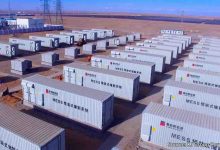China-based manufacturer of lithium-ion batteries Contemporary Amperex Technology Co. Limited (CATL) has delivered what is (confusingly) being described as the world’s first and China’s largest battery energy storage system multi-mixed energy power station as part of the Luneng Haixi Multi-mixed Energy Demonstration Project.
The project is the first of its kind in China to integrate wind, solar, concentrated solar PV (CPV) and an energy storage system in one unified system connected to the grid.
CATL is describing the project as both a world first and China’s largest – one of which is somewhat redundant. According to Dr. Hui Dong, Chief Scientist of China Electric Power Research Institute, the station is “the world’s first and China’s largest electromechanical energy storage station with virtual synchronous generator.”
“The Station is the first of its kind – a multi-functional, centralized power plant integrated with an electrochemical energy storage system,” added Huang Shilin, Vice Chairman and Chief Strategy Officer of CATL. “Its technical reliability and affordability will promote further global deployment of different renewable energy applications.”
Regardless, the project is impressive. The Luneng Haixi Multi-mixed Energy Demonstration Project is made up of 200 MW of solar PV, 50 MW of concentrated solar PV (CPV), 400 MW of wind energy, and a 100 MWh energy storage system, all connected to one another and unified and connected to the grid.
CATL was the battery supplier to the Demonstration Project and took only 17 days to test and commission the battery energy storage system and connect it to the grid. The battery system uses a three-layer relay protection system to ensure the battery system is safe from damage caused by over-charging or discharging, over-current, and fluctuating temperature.
Specifically, the power station is located in Golmud, located in the heart of China and experiencing temperatures which vary from -33.6 to 35.5 degrees Celsius. To ensure, therefore, 15-years of battery performance, CATL used a cooling system that uses air passages and air flow to maintain a consistent temperature inside the battery storage containers.
On top of wildly varying temperatures, Golmud is also in an active seismic zone, which necessarily requires vibration and shock absorption. CATL carried out rigorous testing and simulation and claims that its batteries are able to withstand a potential magnitude 8 earthquake.










